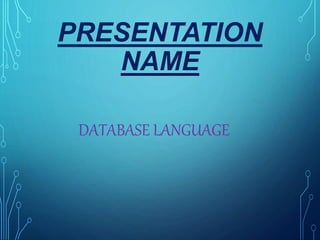Database language
•Descargar como PPTX, PDF•
12 recomendaciones•12,547 vistas
This slide about Database Language.By this slide everyone can easily learn about Database Language.
Denunciar
Compartir
Denunciar
Compartir

Recomendados
Recomendados
Más contenido relacionado
La actualidad más candente
La actualidad más candente (20)
Dbms Notes Lecture 9 : Specialization, Generalization and Aggregation

Dbms Notes Lecture 9 : Specialization, Generalization and Aggregation
Destacado
The slide was made about Basic Database Management system.
If you are a new student for Database Management then you should read this slide. by this slide you can easily gather a quick knowledge about database Management system. so now open this slide and read it.Database management system basic, database, database management, learn databa...

Database management system basic, database, database management, learn databa...University of Science and Technology Chitttagong
Destacado (14)
Relational Database Design - Lecture 4 - Introduction to Databases (1007156ANR)

Relational Database Design - Lecture 4 - Introduction to Databases (1007156ANR)
Database management system basic, database, database management, learn databa...

Database management system basic, database, database management, learn databa...
Similar a Database language
Similar a Database language (20)
Fundamentals of database system - Database System Concepts and Architecture

Fundamentals of database system - Database System Concepts and Architecture
Último
https://app.box.com/s/7hlvjxjalkrik7fb082xx3jk7xd7liz3TỔNG ÔN TẬP THI VÀO LỚP 10 MÔN TIẾNG ANH NĂM HỌC 2023 - 2024 CÓ ĐÁP ÁN (NGỮ Â...

TỔNG ÔN TẬP THI VÀO LỚP 10 MÔN TIẾNG ANH NĂM HỌC 2023 - 2024 CÓ ĐÁP ÁN (NGỮ Â...Nguyen Thanh Tu Collection
Mehran University Newsletter is a Quarterly Publication from Public Relations OfficeMehran University Newsletter Vol-X, Issue-I, 2024

Mehran University Newsletter Vol-X, Issue-I, 2024Mehran University of Engineering & Technology, Jamshoro
https://app.box.com/s/x7vf0j7xaxl2hlczxm3ny497y4yto33i80 ĐỀ THI THỬ TUYỂN SINH TIẾNG ANH VÀO 10 SỞ GD – ĐT THÀNH PHỐ HỒ CHÍ MINH NĂ...

80 ĐỀ THI THỬ TUYỂN SINH TIẾNG ANH VÀO 10 SỞ GD – ĐT THÀNH PHỐ HỒ CHÍ MINH NĂ...Nguyen Thanh Tu Collection
Último (20)
Basic Civil Engineering first year Notes- Chapter 4 Building.pptx

Basic Civil Engineering first year Notes- Chapter 4 Building.pptx
TỔNG ÔN TẬP THI VÀO LỚP 10 MÔN TIẾNG ANH NĂM HỌC 2023 - 2024 CÓ ĐÁP ÁN (NGỮ Â...

TỔNG ÔN TẬP THI VÀO LỚP 10 MÔN TIẾNG ANH NĂM HỌC 2023 - 2024 CÓ ĐÁP ÁN (NGỮ Â...
Micro-Scholarship, What it is, How can it help me.pdf

Micro-Scholarship, What it is, How can it help me.pdf
UGC NET Paper 1 Mathematical Reasoning & Aptitude.pdf

UGC NET Paper 1 Mathematical Reasoning & Aptitude.pdf
Unit 3 Emotional Intelligence and Spiritual Intelligence.pdf

Unit 3 Emotional Intelligence and Spiritual Intelligence.pdf
Salient Features of India constitution especially power and functions

Salient Features of India constitution especially power and functions
General Principles of Intellectual Property: Concepts of Intellectual Proper...

General Principles of Intellectual Property: Concepts of Intellectual Proper...
80 ĐỀ THI THỬ TUYỂN SINH TIẾNG ANH VÀO 10 SỞ GD – ĐT THÀNH PHỐ HỒ CHÍ MINH NĂ...

80 ĐỀ THI THỬ TUYỂN SINH TIẾNG ANH VÀO 10 SỞ GD – ĐT THÀNH PHỐ HỒ CHÍ MINH NĂ...
Interdisciplinary_Insights_Data_Collection_Methods.pptx

Interdisciplinary_Insights_Data_Collection_Methods.pptx
Database language
- 2. #WHAT IS DATABASE MANAGEMENT SYSTEM?? A database management system (DBMS) is system software for creating and managing database. The DBMS provides users and programmers with a systematic way to create, retrieve, update and manage data. #There are many part of DBMS: • Introduction to Database Management System • DBMS vs File System • View of data • Data models • Database Languages. • Database users and administrators • Transaction Management • Database System Structure • Application architectures
- 3. # In DBMS has 3 types language: *Data Definition Language(DDL). *Data Manipulation Language(DML). *Data Control language (DCL). #Data Definition Language(DDL): • Database language that is used to create, delete or modify database schema is called DDL. • It is used by Database Administrators(DBA) to specify the conceptual schema. • DDL interpreter converts DDL statements into equivalent low level statements understood by the DBMS. • Normally, create, alter, and drop statements are DDL statements. • DDL statements make changes in the schema
- 4. Example: For alter command Alter table Student ADD COLUMN address varchar(20) ; Example: For drop command drop Student; Example: For create command create table Student ( sid number(4), sname varchar2s(50), DOB varchar2(15) );
- 5. *DATA MANIPULATION LANGUAGE(DML) • Database language that enables insert, update, delete, and retrieval of data from the database is called Data Manipulation Language. • DML complier converts DML statements into equivalent low level statements that the database understands. • Normally, insert, update, delete, select are DML commands. • DML reflects change in the instance, not the schema
- 6. Example: For insert Insert into Student values(“A-101”, “Ramesh”, 12); Example: for update Update Student Set class = 11 Where sid = “A-101” ; Example: for select Select * From Student Example: For delete Delete from student Where sname = “RAj”
- 7. •Data Control language (DCL): DCL statements control access to data and the database using statements such as GRANT and REVOKE. A privilege can either be granted to a User with the help of GRANT statement. The privileges assigned can be SELECT, ALTER, DELETE, EXECUTE, INSERT, INDEX etc. In addition to granting of privileges, you can also revoke (taken back) it by using REVOKE command.
- 9. *In SQL, cases are insensitive. So, instead of Student one can write StUdEnT as well. * Also, for integer values “12” is incorrect but 12 is correct. *And, for char and varchar “course” is correct and course is incorrect. Note that
